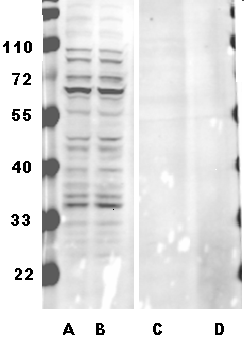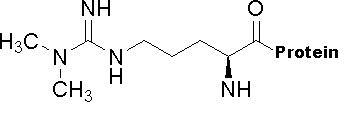联系我们
电 话:0771-2310996
传 真:0771-2310995
E-mail : 735565094@qq.com
技术支持E-mail: immunechem@gmail.com 备案号:桂ICP备09007987号
地 址:广西南宁市高新技术开发区科园大道68号东盟慧谷11栋203室 530007
|
Catalog # Product Description |
ICP0810 This antibody was raised from rabbits that were immunized with NG,NG-dimethyl arginine-KLH conjugates and specifically isolated and affinity purified using the NG,NG-dimethyl arginine antigen. The affinity purified methyl arginine antibody is useful for detection, isolation and localization of proteins with methylated arginine (asymmetric dimethylation) residues. |
|

Western blot of human MMRU cells with ICP0810 (A,B) plus competitive inhibition with free dimethyl arginine (C,D)

Antigen Structure
![[Exposure:10 Milliseconds]](/fsuploads/2019/06/201906241732413.png)
IF Staining of MMRU cells
|
|
Species
|
Rabbit
|
||
|
Formulation
|
250μg/mL antibody stored in PBS, 50% glycerol
|
||
|
Immunogen
|
NG,NG-dimethyl arginine-KLH conjugates
|
||
|
Purification
|
Antigen-specific immunoaffinity purification with NG,NG-dimethyl arginine and adsorbed with NG-monomethyl arginine
|
||
|
Specificity
|
The antibody recognizes proteins with dimethylated arginine residues. It does not cross-react with acetylated proteins or monomethylated proteins.
|
||
|
Species Tested
|
Human, mouse and pig
|
||
|
Applications
|
ELISA (1:2000); WB (1:1000); IP (5 µg/mg protein sample); IF (5 µg/mL); IHC (5 µg/mL)
|
||
|
Scientific Description
|
Arginine methylation is a very common post-translational modification that occurs predominantly in the nucleus. The main pool of proteins that are modified possess RNA binding properties. More broadly, arginine methylation has been implicated in a variety of cellular processes, including protein trafficking, signal transduction and transcriptional regulation.
|
||
|
Storage & Stability
|
Product is stable for several weeks at 4°C. For extended storage, store product at –20ºC. Expiration date is one year from date of shipping if properly stored.
|
||
|
Product Specific References |
1. J. Proteome Res. 2013. 12 (9): 3884-3899. doi:10.1021/pr400556c 2. Mol. Microbiol. 2007. 65 (3): 590-606, doi:10.1111/j.1365-2958.2007.05831.x 3. Proteomics. 2016. 16 (3): 465-476. doi: 10.1002/pmic.201400564 4. Proteomics. 2013. 13 (7): 1059-1064. doi: 10.1002/pmic.201200477 5. Proteomics. 2015. 15 (18): 3209-3218. doi: 10.1002/pmic.201500075 6. J. Neurosci. 2015. 35 (37): 12890-12902. doi: 10.1523/JNEUROSCI.0246-15.2015 |